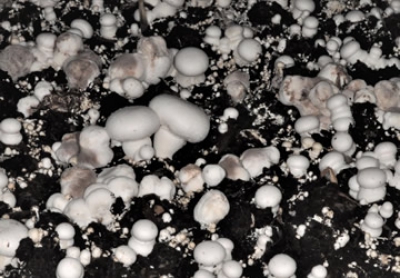Dry bubble disease may cause a lot of problems because the spores spread quickly. It’s essential to identify and remove the first affected mushrooms to prevent an outbreak of the disease throughout your entire nursery. So how do you remove the first infected mushrooms?
Dry bubble disease is spread by spores. The spores are sticky and are spread by any carrier to which they may adhere, such as people, flies, dust, water, etc.
The best way of preventing the spread of spores is by covering an infected mushroom and removing it. Wet a tissue with a disinfectant such as alcohol or methylated spirits. The spores will stick to a wet tissue. Carefully and slowly place the wet tissue over the infected mushroom without causing any turbulence, which would make the spores fly away. When you have covered the mushroom with the tissue, cover your hand with a plastic bag and pick up the mushroom along with a good amount of the surrounding casing soil. Turn the bag containing the infected mushroom and the casing soil inside out and seal it. Leave the bag containing the infected mushroom in the growing room and dispose of it after you have steamed the growing room.
There are other methods you could use, for example with a plastic bottle. Cut off the bottle’s base, place the bottle over the infected mushroom and fill it with salt.
Whichever method you use, make sure you don’t spread the spores. A single drop of water on an infected mushroom would spread billions of spores over a distance of more than one metre from the mushroom. A few days later you would then see lots of mushrooms showing the first signs of dry bubble disease around that first mushroom.
Regularly check the area from which you have removed the infected mushroom during the next few days to see whether the disease reappears.
More information on how to control dry bubble disease can be found on pages 114-116 of the Mushroom Signals book.
Mark den Ouden
The next Master class Mushroom composting and growing is 21 – 26 October, there are still seat available, more information about the course, click here.
Dry bubble disease
Aug 27,
2019
Latest from Mushroom Matter
- e-nema at the Mushroom Days: natural power for healthy mushrooms
- Possible mechanisms involved in the fruiting of the cultivated mushroom - by David M. Beyer
- From concept to capability: how integrated robotics are redefining mushroom harvesting
- Latest newsletter
- If you remove the mushroom, nature falls apart






















